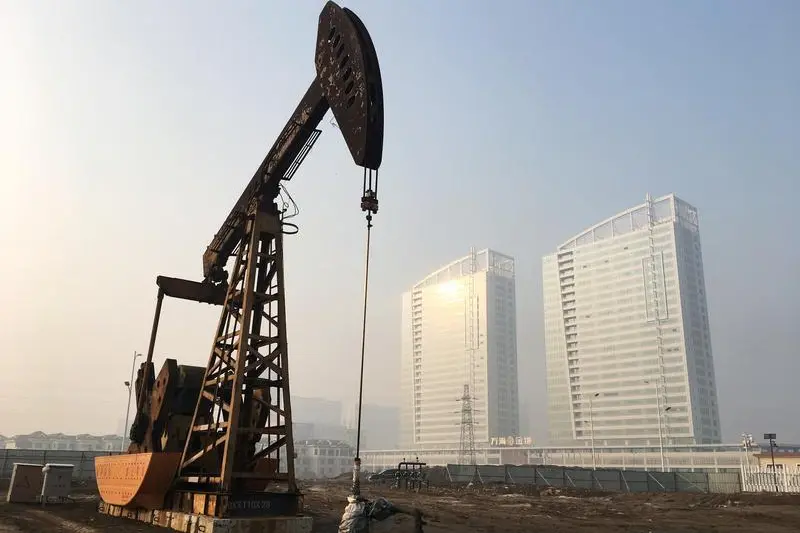PHOTO
(The views expressed here are those of the author, a columnist for Reuters.)
SYDNEY - China's crude oil surplus nearly halved in October, but this was a further sign of weakness as both imports and refinery runs dipped.
The volume of excess crude was about 550,000 barrels per day (bpd) in October, according to calculations based on official data, down from 930,000 bpd in September.
In more normal circumstances, a decline in crude flowing into inventories may be viewed as a sign that demand was picking up, but so far 2024 is far from a normal year for China's oil sector.
The dynamic at play in October was that crude imports fell by more than refinery throughput, thus trimming the amount of spare crude.
China, the world's biggest crude importer, doesn't disclose the volumes of oil flowing into or out of strategic and commercial stockpiles, but an estimate can be made by deducting the amount of crude processed from the total of crude available from imports and domestic output.
Domestic production in October was 4.04 million bpd, up 2.5% from the same month last year, according to data from the National Bureau of Statistics, while imports were 10.53 million bpd.
Putting domestic output together with imports gives a combined total of 14.57 million bpd available for processing in October, down from 15.22 million bpd in September.
Refinery throughput was 14.02 million bpd in October, down from 14.29 million in September.
This means that refineries processed 550,000 bpd less than what was available from the combined total of imports and domestic production.
This was lower than the surplus of 930,000 bpd from September, and the drop in the October figure was enough to lower the excess crude for the first 10 months to 1.05 million bpd from 1.10 million bpd over the first three quarters.
It's worth noting that not all of this surplus crude is likely to have been added to storage, with some being processed in plants not captured by the official data.
But even allowing for gaps in the official data, it's likely that China has been importing crude at a far higher rate than it needs to meet its domestic fuel requirements.
PROFIT BATTLE
There are some short-term factors that have resulted in lower refinery processing, with smaller, independent refineries struggling to make profits amid soft demand for diesel and gasoline.
This has led to some of them reducing operating rates, with data from consultancy Sublime China Information showing these plants, mostly located in the refining hub of Shandong province, were operating at 58.7% of their capacity by late October, down from 77% a year earlier.
China's regulated fuel prices may garner some of the blame for cutting margins for refiners, which have to buy crude at international prices.
It's also the case that the world's second-largest economy is battling to build growth momentum, with Beijing's stimulus measures underwhelming market watchers and as yet failing to reverse the downtrend in the key property sector.
But there is also a structural shift underway in China's crude oil demand, with the rapid uptake of what Beijing terms new energy vehicles, which include full electric vehicles and hybrids, cutting into gasoline demand.
A switch to trucks powered by liquefied natural gas has cut diesel demand, and the ongoing development of battery-powered heavy vehicles means this trend may accelerate in coming years.
The move to LNG is largely driven by price as it is cheaper than diesel, while also delivering some environmental benefits.
For light vehicles, government subsidies for consumers to switch to new energy cars have boosted sales, but China's competitive advantage in making these types of vehicles means they have become cheaper to own and operate than their gasoline equivalents.
China's soft economy and its push to cut the use of vehicles using products derived from crude oil has meant that expectations for strong demand growth that were common among forecasters earlier this year have been overly optimistic.
The Organization of the Petroleum Exporting Countries (OPEC) was among the most bullish, forecasting in July that China's oil demand growth would rise by 760,000 bpd in 2024.
The group cut this back to 580,000 bpd in its October report, but given that crude oil imports are down 420,000 bpd in the first 10 months of 2024 from the same period last year, even this reduced figure looks way too high.
Throw in further risks to China's economy from a potential trade war with the United States when Donald Trump starts his second term as president in January, and it's a challenge to find anything bullish in China's oil outlook.
The views expressed here are those of the author, a columnist for Reuters.
(Editing by Sonali Paul)























